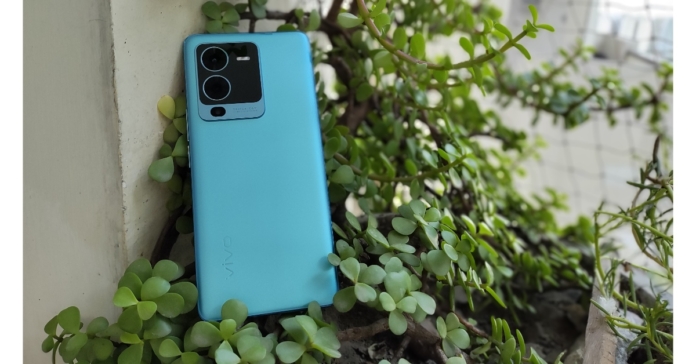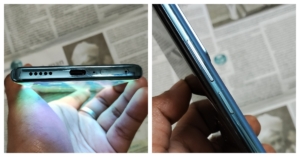Vivo V25 Pro Review: Design and Display
The V-Series from Vivo is highly known for both its aesthetic appeal and advanced photography capabilities. The company makes an effort to introduce something fresh with each new iteration. However, ever since Nothing Phone 1 (Review) entered the market it is already generating a lot of talk among tech enthusiasts with its groundbreaking design, which is undoubtedly cutting edge, good gaming performance, and many other features. Vivo recently released the Vivo V25 Pro in the market at a comparable price range.
Because it now has a larger battery capacity, the V23 Pro is no longer as light and is even on the heavier side compared to its predecessor. More specifically, the Vivo V25 Pro’s rear panel has a colour-changing anti-glare glass that changes colour when exposed to sunlight, and also adds a bit of weight. It comes in a single Sailing Blue finish. It should be noted that the Vivo V23 Pro was the device that initially featured the colour-changing design concept (review). Due to the matte texture on the back panel, scratches and fingerprints are actually resisted.
Unlike its predecessor, the phone’s camera module looks relatively ordinary. Most modern smartphones have camera modules that are square in shape and have a very similar appearance. The medium-sized display notch that houses the two selfie cameras on the V23 Pro was one element that seemed a little old. In order to make it look much easier on the eye and less distracting, Vivo has now reduced that number to one and housed it into a hole-punch hole. A secondary noise-cancelling microphone is located on the frame’s top, and the power and volume rocker buttons are located on the frame’s right. On the phone’s bottom are a SIM tray, a type-c port, and a speaker grille.
The Vivo V25 Pro does not have an IP rating, which was also lacking with the previous version and is something we would not reasonably anticipate from a phone in this price bracket. The 6.56-inch FHD+ 3D Curved AMOLED display on the Vivo V25 Pro is an improvement over the 90Hz panel on the V23 Pro, offering a touch sampling rate of 300Hz and a high refresh rate of 120Hz for an improved viewing and browsing experience. It also supports 100% of the DCI-P3 broad colour gamut and a contrast ratio of 6,000,000:1 to provide a more immersive viewing experience. Along with that, it has HDR 10+, Netflix HDR, and SGS Low Blue Light certifications.
A very responsive in-display fingerprint sensor and a very elegant design are both features of the display. Even though it has a fairly wide display, holding it in your hand is really pleasant. It has curved edges and a bezel-free display. We really enjoyed using this phone because it has an edge-to-edge screen and the videos have great graphics, colours, and contrast. It provides great, sharp, vibrant pictures and even supports HDR on YouTube and Netflix. The range of viewing angles is unlimited. As a result, using the gadget gives you a great multimedia experience. When used outdoors or in intense sunshine, the phone’s display can reach a maximum brightness of 1300 nits and everything is very legible. Although you can choose a refresh rate of 60Hz or 120Hz in the display settings, Smart Switch is turned on by default. The processor in this phone is really quick and can handle everything, therefore we used the phone at 120Hz. The curved display makes the phone look more luxurious. We anticipated stereo speakers, but there is only one bottom-firing speaker. However, it supports Hi-Res audio, has good sound quality, and is loud.
Vivo V25 Pro Review: Performance and Cameras
Vivo V25 Pro’s software is already pre-installed with Funtouch OS 12, which is based on Android 12. One thing to keep in mind is that although there is a lot of bloatware, you can remove it. Fortunately, it does not significantly alter the Android UI experience. It also has several customization options, such as eye protection on the display, the option to change the screen mode, and the ability to add dynamic effects. There is a dedicated gaming mode called Vivo’s Ultra Game Mode that provides some good software features for gamers. The font styles can also be modified. The MediaTek Dimensity 1300 SoC, which is power-efficient and performs just like the Snapdragon 870 SoC, powers the Vivo V25 Pro. In our tests, it looked impressive, and we used the 8GB RAM with 128GB storage configuration. There is also a RAM boost option that gives you 8 GB of additional virtual RAM, bringing the total amount of virtual RAM to 16GB (including the 8GB of physical RAM). We played Call of Duty at its highest settings and were really pleased with how it performed. While 90FPS may also be used to play PUBG New State, it did so quite successfully. However, the curved display may cause some unintentional touches, but the combination of the 300Hz touch sampling rate and the 120Hz refresh rate raises the bar for gaming. Additionally, we had no thermal problems, jitters, frame dropouts, or slowdowns with this phone. In terms of connectivity, you get eight 5G bands to support, dual 4G VoLTE, Wi-Fi calling support and more. We’ll now discuss the Cameras, which is the review’s second-most crucial section in our honest opinion. Yes, the Vivo V-Series is a camera-focused line of smartphones, so whatever camera enhancements you get should be thoroughly tested. Previously, the V23 primary camera, which had a resolution of 108 megapixels, has been dropped to 64 megapixels, but it now incorporates optical image stabilisation (OIS). The 2-megapixel macro camera and 8-megapixel ultra-wide-angle camera appear to be the same as before. The V25 Pro’s 32-megapixel selfie camera is a sort of drop from the 50-megapixel one on the V23 Pro.
The primary sensor captures some detailed images with good sharpness levels in daylight, which are quite noticeable when zooming in. Despite a tendency to oversaturate the sky colours, the colours are generally nice. There is nothing wrong with the dynamic range, and it is also good.
Moving on to the 8MP ultra-wide sensor, the photographs contain decent detail but, obviously, just acceptable levels of sharpness for an 8MP sensor. The corners are soft and lack detail. While the colours are pleasantly accurate and nearly on par with those of a primary sensor. Regarding the close-up photos in this post, you can notice good details and the images are sharp. The primary camera can take quality pictures, thus the colours are also fairly true and appear amazing. While the 2MP sensor produces dull-looking macro photographs, the images have been fine-tuned to make them look passable, despite the fact that the sensor as a whole is not ideal for macro photography. The portraits you see here are well-done; the skin tones, sharpness, and details are all excellent. While colours are a little vibrant, edge detection is also done well. There are several choices to experiment with when using the portrait setting, including bokeh, beauty mode, and others. For portraits, the night mode also appears to be wonderful and reliable. When zoomed in, low-light indoor photographs have less noise and are more or less clear. However, when the night mode is activated in extremely low light levels, you can see fine details while the noise is somewhat tamed, but the edges appear a bit fuzzy and soft. Moving on to the selfie camera, the 32MP front sensor does a commendable job, with good sharpness and details. The skin tone also appears to be natural. Although night mode is also available for selfies, low-light selfies also work well. Selfies can be taken in portrait mode, which is also an option and does a respectable job overall.
The Vivo V25 Pro can capture videos in 4K at 60 frames per second without stabilisation. Therefore, even if the quality is superb, this mode is not advised for recording moving footage. With OIS and EIS, you can also shoot in 4K at 30 frames per second, and the results are fairly consistent and attractive. The video quality at [email protected] is excellent, and the colours and sharpness are both excellent. EIS is supported in [email protected], and slow motion is also an option. Stabilised video recording at the night is also an option. The battery’s capacity has increased from 4,300mAh in the V23 Pro to 4,830mAh, which is excellent to have because the V23 Pro’s battery life was lacking when used often. The charging, which has increased from 44W to 66W, is another improvement.
Verdict
Without a doubt, we would claim that the Vivo V25 Pro is a stunning and camera-focused smartphone. The curved display, colour-changing design, and 66W fast charging are a few small improvements. The IP certification, stereo speakers, and 3.5mm jack are all missing, though. Both the front and back cameras perform brilliantly. The daylight captures turned out quite great, and the subsequent low light experience is also quite good. Vivo’s most recent smartphone from the V series seems to be a powerhouse despite its higher-than-anticipated pricing. Vivo V25 Pro is our recommendation if you’re searching for a mid-range premium smartphone that focuses on photography. For the latest gadget and tech news, and gadget reviews, follow us on Twitter, Facebook and Instagram. For newest tech & gadget videos subscribe to our YouTube Channel. You can also stay up to date using the Gadget Bridge Android App. You can find the latest car and bike news here.









